
About UsThe Numismatic Bibliomania Society is a non-profit organization promoting numismatic literature. For more information please see our web site at coinbooks.org SubscriptionsThose wishing to become new E-Sylum subscribers (or wishing to Unsubscribe) can go to the following web page link MembershipThere is a membership application available on the web site Membership Application To join, print the application and return it with your check to the address printed on the application. Membership is only $15 to addresses in the U.S., $20 for First Class mail, and $25 elsewhere. For those without web access, write to: David M. Sundman, Secretary/TreasurerNumismatic Bibliomania
Society AsylumFor Asylum mailing address changes and other membership questions, contact David at this email address: dsundman@LittletonCoin.com SubmissionsTo submit items for publication in The E-Sylum, just Reply to this message, or write to the Editor at this address: whomren@coinlibrary.com
BUY THE BOOK BEFORE THE COINYou won't regret it! |
- WAYNE'S WORDS: THE E-SYLUM DECEMBER 5, 2010
- CHARLES DAVIS: REMEMBRANCES OF AL HOCH
- LAKE BOOKS 105TH MAIL-BID SALE PRICES REALIZED AVAILABLE
- NEW BOOK: THE SECRET HISTORY OF THE FIRST U.S. MINT
- NEW EDITION: BRITISH COMMEMORATIVE MEDALS AND THEIR VALUES
- LARRY GAYE ON THE ENCYCLOPEDIA OF ROMAN IMPERIAL COINS II
- BOOK REVIEW: ANNUAL ASSAY COMMISSION – UNITED STATES MINT 1800-1943
- HARRY X BOOSEL'S 1873 COINAGE BOOK COVER PRINTING PLATE
- FEDERAL RESERVE TO OPEN DENVER MONEY MUSEUM
- THE STORY OF THE TRUMAN LIBRARY COLLECTION
- QUERY: ENCASED COIN INFORMATION SOUGHT
- QUERY: GDC CASINO TOKEN MINT MARK
- THE ANA SCHOOL OF NUMISMATICS
- CARNEGIE HERO FUND MEDALS
- MORE ON SABINE PASS MEDAL COPIES
- NOTES FROM E-SYLUM READERS: DECEMBER 5, 2010
- ON SWITCHING FROM AOL
- OBAMA PARDONS MAN CONVICTED OF COIN MUTILATION
- ANCIENT COINS STOLEN FROM GERMANY'S FROM FROM SCHLOß HOHENTÜBINGEN
- FEATURED WEB PAGE: ARTISTS ON BANKNOTES
WAYNE'S WORDS: THE E-SYLUM DECEMBER 5, 2010

Among our new subscribers this week are Richard Marlor, and Dan Vial. Welcome aboard! We now have 1,387 email subscribers, plus 101 followers on Facebook, including Ian Fenn, Evgeni Paunov and Eko Santozo.
One email subscriber we lost wrote: "I unsubscribed because for two weeks in a row I had to look at Sarah Palin's mug and read about her. I'm sorry but this, at least in my humble opinion, does not belong in a numismatic publication no matter how very slight the tie-in."
Well, the same article generated comments that we were both promoting and bashing you-know-you. I may publish a Rorschach inkblot sometime, just to see what people read into that...
This week we open with several remembrances of numismatic publisher Al Hoch, followed by an update from Fred Lake of Lake Books. Next up are articles on two new numismatic books and two book reviews.
Other topics include the Green Duck Corporation, the Truman Library coin collection, encased coins, and the Money Museum in Denver (no, not THAT Money Museum - another one). To learn about the printing plate for the cover of Harry Boosel's 1873 book, the ANA School of Numismatics, and Grandpa Cheney's "Carnegie Medal", read on. Have a great week, everyone!
Wayne Homren
Numismatic Bibliomania Society
CHARLES DAVIS: REMEMBRANCES OF AL HOCH
 Every now and then in life, you meet people who are large souls. Al Hoch was one of those. No person in numismatics did so much for the hobby while shunning any recognition. I have very fond memories of him, a few of which I will share.
Every now and then in life, you meet people who are large souls. Al Hoch was one of those. No person in numismatics did so much for the hobby while shunning any recognition. I have very fond memories of him, a few of which I will share.
In 1990, I approached him to publish a book I was writing. I dearly wanted the Quarterman QP logo on the spine, as that would give the book more credibility than if it were just privately published. Al agreed, but said that it would be to my advantage to pay the printing/binding bill and receive the entire print run rather than sending it to the warehouse for his distribution. As we were using one of his regular printers, the contract came with Quarterman’s credit terms - payment 45 days after delivery. By the time the bill came due, the project was already in the black costing me nothing out of pocket. Other than two working dinners at Legal Seafood in Cambridge, he refused to take any compensation.
The Quarterman imprint has always stood for quality. Al used a 200-300 dpi screen when reprinting most plates at a time others settled for 100. His reprint of the Maris Woodburytype plate, which he did for me in 1987 using what he called the “fancy process,” is so deceptive, that when it and an original were shown to a New Jersey specialist side by side, and he was asked to select which was which, he picked the wrong one as the original. In a rare show of satisfaction with his own work, Al asked me to mark the reprints “copy” on the reverse.
While Al had published several volumes under his own name for TAMS, and with Ted Craige the first reprint of Dalton & Hamer (incorrectly referred to as the Seaby reprint; all they did was slap their own dust jacket on it), he opened Quarterman in 1972 reprinting needed works in the token, medal and early coppers fields. But they weren’t just straight reprints with most adding extra value.
His edition of American Colonial History Illustrated by Contemporary Medals included a photo supplement of medals from the collection of Leonard Finn, Al shooting the photos on Finn’s kitchen table. Today, his reprint of Betts often sells for more than the unillustrated 1894 original.
New forewords, supplements and corrections marked almost every one of his productions. Changes in Penny Whimsy are subtle, as he and Sheldon made corrections in the text which were typeset in matching font on strips of paper and pasted over the old text on the repro master making a true 1st revised edition. Early Coins of America contains a 28 page foreword by Eric Newman, and A Historic Sketch of the Coins of News Jersey has one of 4 pages by Walter Breen. And his monumental reprint Medallic Illustrations of the History of Great Britain and Ireland brought that unwieldy 18 fascicule elephant into a single, if weighty, volume. It should go without saying that a library of Quarterman titles has more research value than a library of the originals from which they were made.
For years Al avoided major coin conventions and he preferred to meet in Nashua (NH) at a mall show where I had a table twice a year. There, he once sold me a Bank of New York Fugio for $700 for which I paid cash that he stuffed into the pocket of London Fog raincoat. The Fugio was partly red and I asked him if he wanted to see photos of 1794 cents in the same condition printed as “cibachromes” This of course was the special edition of the John Adams catalogue published by Bowers & Ruddy in 1982 as a fixed price list.
Al gazed at the coins on the plates for a minute, then rolled his eyes and said. “Charlie, I have been in psycho-analysis for 20 years, but this is the meaning of life.” He then got up and started to walk out, oblivious to the fact that $100 bills that I had just given him were falling out of his pocket and were spewing over the mall floor. I retrieved them for him, but I think the Adams large cents had put him in a temporary trance.
The 1960 ANA convention in Boston was a happening, perhaps not recognizable as such at the time, but as the years go by, it is defining itself with an extraordinary assemblage of minds. The banquet photograph depicts a group in the center of the room at a table set for 10 with 5 younger numismatists with their wives or dates - Q. David Bowers, Ken Bressett, George Fuld, Dick Johnson and Ken Rendell. 50 years later each of these has reached the pinnacle of success in cataloguing, publishing and research.
If there had been another seat at the table, Al Hoch would surely have belonged in their company (or would they have belonged in his?). As Al lived most of his numismatic life in Boston’s suburbs, I asked him why he was not to be seen in the photo. His answer was that with a growing family, he could not justify $5 for the banquet ticket and he and Walter Breen went out for hot dogs instead.
In 1992, I convinced him to go to the A.N.A. Convention in Orlando and participate in the numismatic symposium with John Adams, Dave Bowers and Eric Newman. Not known to him was that N.B.S. had planned a special achievement award to be presented at the club’s general meeting. I had the honor of making the presentation from the podium, and as he came forward to receive the plaque, the 100 or so attendees jumped into a standing ovation as if they were sitting on ejector seats and I had pushed a button. I remember the first person up was Michael Hodder, and half a second later the whole hall was up too. The recognition was more than Al could deal with, and he changed his plane reservation home and left the next morning, not wishing to spend any more time in the limelight.
These and other stories are obviously personal and I will hold their memory close. For those not lucky enough to have known him, I would ask you to reflect occasionally when you take a Quarterman title off the shelf or read an issue of his brain child Colonial Newsletter, how fortunate we are to have had Al Hoch in our world. He really did make a difference, and we will miss him.
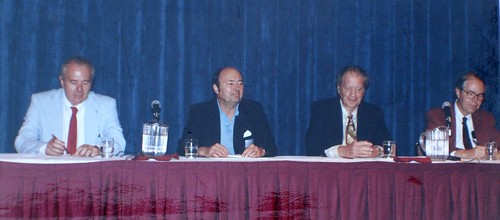
Pete Smith writes:
A listing of Quarterman publications in English was published in The Asylum, Vol. IX, No. 3. At that time the list included 24 titles.
George Fitzgerald writes:
My only remembrance of Al Hoch was at a Boston ANA Convention in Boston in the 80's. I met him as Ken Bressett introduced me to Al. I had just purchased one of the Quarterman reprints and had it with me. I mentioned to him that I had purchased it at a discount from some dealer. I knew that Al did not like collectors buying books at a discount.
I mentioned to him that I had over 200 books on Numismatics. I looked at him and he didn't say anything. My only meeting with him, and I do remember that he said nothing after I told him about my vast library.
Rich Hartzog writes:
I knew Al for over 35 years and considered him a good friend. He was generous with his time, and helped me to understand the philosophy of publishing books, and how to deal with printers with exact specifications. We met a few times over the years, mostly communicating via phone and letter.
During the August 2010 ANA Convention in Boston, I rented a car and drove up to see him for the day. He had wanted to attend the ANA, but his Parkinsons and other problems prevented him from driving long distances. He was living in a two-bedroom apartment, soon to be evicted to make way for condos. It was cluttered with posters, filling the dining room, second bedroom and closets, stacked everywhere. He had gotten out of numismatic collecting, into posters and paper items, and considered himself to be quite knowledgeable. Coming from an MIT graduate, this was really impressive.
As I flipped through posters, he had detailed comments on each, not only on the subject matter, but the rarity and desirability of each. He had recently sold some expensive posters and was considering buying rare exonumia as an investment (at age 75!). I suggested he contract with a local seller or myself to sell off his posters, but he could not bear to part with them. He said I should come back for a visit, to learn the poster market, but I failed to make the time.
While there he showed some pages from his recently finished formula for predicting the supposedly unpredictable. Al said he had spent well over 10,000 hours on it over the decades, and thought he would be able to predict stock market moves and make his fortune. While I have a degree in mathematics, his equations were beyond my expertise! An interesting concept, but one that most claim is impossible.
Al had studied his various ailments on-line, and had tweaked his medicines to the point where he was able to control virtually all the effects of Parkinsons and his other problems. We had a nice lunch at a local restaurant (where everyone knew him by name), discussed the book business, posters, the state of the exonumia market and life in general. By the end of the day he was noticeably tired, and I returned to Boston, and then to home. Al was a good friend, and I will miss him.
n=alfred-d-hoch&pid=146916074). -Editor
To read the earlier E-Sylum article, see: NUMISMATIC PUBLISHER AL HOCH, 1935-2010 (www.coinbooks.org/esylum_v13n48a02.html)
THE BOOK BAZARRE
JANUARY 8, 2011 NEW YORK AUCTION SALE500 Lots Comprising a Remarkable Selection of Outstanding Works on Ancient, Medieval and Modern Numismatics Featuring RARE WORKS ON RUSSIAN NUMISMATICS THE LATIN AMERICAN LIBRARY OF ALAN LUEDEKING AND THE JEFF HOSFORD COLLECTION OF CROSBYANA Catalogue Available at Our Web Site: www.numislit.com
Illustrated Catalogues $25.00
141 W JOHNSTOWN ROAD, GAHANNA OH 43230-2700
(614) 414-0855 • df@numislit.com • GFK@numislit.com
LAKE BOOKS 105TH MAIL-BID SALE PRICES REALIZED AVAILABLE
 The prices realized list for Lake Books' 105th mail-bid sale of numismatic literature is now available for viewing at
www.lakebooks.com/current.html
The prices realized list for Lake Books' 105th mail-bid sale of numismatic literature is now available for viewing at
www.lakebooks.com/current.html
Reference material on tokens and medals led the way with other favorites being World auction catalogs, United States material and books on Paper Money showing strong pricing.
Our next sale will be held in early February, 2011 and will feature material from an impressive list of consignors.
Have a Happy Holiday Season
Lake Books
6822 22nd Ave. N.
St. Petersburg, FL 33710
727-343-8055 Fax 727-345-3750
NEW BOOK: THE SECRET HISTORY OF THE FIRST U.S. MINT
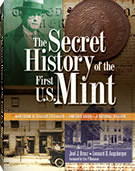 How did the son of a poor farmer grow up to buy a priceless treasure of American history? And why—if his mission was preservation—did he ultimately destroy it?
How did the son of a poor farmer grow up to buy a priceless treasure of American history? And why—if his mission was preservation—did he ultimately destroy it?
Frank H. Stewart is both the hero and the villain in this remarkable tale ripped from the headlines of early 20th-century Philadelphia. He was a high-school dropout . . . who wrote the definitive history of our nation’s first coin factory. He was no art connoisseur . . . and yet he commissioned unforgettable paintings of the first U.S. Mint, by famous artists. A poor boy made good, Stewart bought the old Mint, labored to preserve it, and failed in the most dramatic way possible.
Could his later acts of commemoration redeem his failures in preservation?
The Secret History of the First U.S. Mint tells, for the first time, the full story of the paradoxical Frank H. Stewart and his self-appointed life’s mission to celebrate an irreplaceable slice of our nation’s heritage. This groundbreaking new book is filled with dozens of sketches, paintings, and photographs of the first Mint that have been preserved in archival collections for decades, and have not been seen by living numismatists until now.
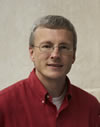
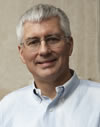
Authors Len Augsburger and Joel Orosz
The Secret History of the First U.S. Mint will debut at the FUN Show in January 2011. After that it will be available online (including here, at whitmanbooks.com) and from booksellers nationwide.
NEW EDITION: BRITISH COMMEMORATIVE MEDALS AND THEIR VALUES
Chris Eimer writes:
I shall be at my usual table at the New York International Numismatic Convention in early January 2011 with copies of the book, which will also be available on the stands of Charles Davis and Spink.
Anyone wishing to have further details can contact the publishers or myself directly at art@christophereimer.co.uk
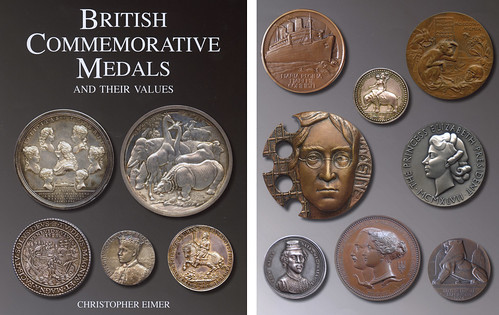
by
CHRISTOPHER EIMER
London, 2010. Publisher: Spink
Quarto, pp. 326 and 249 plates (2000+ images)
Casebound with dust jacket.
Numbered Edition of 2000
Price £75.00
British Commemorative Medals and their Values lists more than 2200 medals. All are fully described, with biographical and historical information and a guide to current market values.
The book includes notes on using the catalogue, an introduction to the medal in Britain and a chapter with production figures. A comprehensive general index allows medals to be located under sitter and subject-matter, and an index of medallists provides details of more than 500 engravers and those associated with the manufacture and publication of medals.
With a considerable amount of information within its covers, the book has been designed for practical use, always with the reader in mind. It will serve collectors and dealers as well as those with a broader interest in the arts, scientific developments, naval and military campaigns and social and political history.
Christopher Eimer, M.Phil, FSA, is a dealer in coins and medals, whose interest in numismatics goes back to the mid-1960s. His other publications include The Medallic Portraits of the Duke of Wellington (1994); and The Pingo Family and Medal-Making in Eighteenth-Century Britain (1998).
The first edition of British Commemorative Medals and their Values was published by Seaby’s in 1987. The book comprised 265 pages, with 53 plates and 650 images, and it was issued with a cover price of £30 and a print-run of 1500 copies. It soon established itself as a standard work of reference and was awarded the Mishler Medal in 1988 by the Token and Medal Society of America.
Since going out of print in the early 1990s, second-hand copies have been fetching up to five times the original cover price. The 2nd edition maintains the same format, design layout and entry numbers as the original edition, although it has an additional 60 pages of text and 196 plates, which are now in colour.
LARRY GAYE ON THE ENCYCLOPEDIA OF ROMAN IMPERIAL COINS II
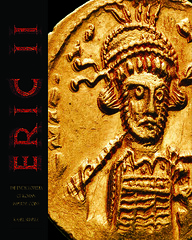 I have to jump on the ERIC II bandwagon because you need one to get it home after your purchase. I bought two copies at the Salem, Oregon’s Coin Club’s Thanksgiving coin show. Fortunately I had my pack cat with me to assist me in getting my copies to the car. I purchased my copies from Scott & Lisa Loos; they brought six copies and sold out.
I have to jump on the ERIC II bandwagon because you need one to get it home after your purchase. I bought two copies at the Salem, Oregon’s Coin Club’s Thanksgiving coin show. Fortunately I had my pack cat with me to assist me in getting my copies to the car. I purchased my copies from Scott & Lisa Loos; they brought six copies and sold out.
What was quite interesting was when I returned home and checked my emails there was my copy of The E-Sylum with Paul DiMarzio’s review. "ERIC II", "The Encyclopedia of Roman Imperial Coins II" is a most excellent and much needed book for anyone interested in Roman and Byzantine coinage. Because of the sheer size of the book it is most aptly titled as an encyclopedia rather than as a handbook. Thanks Ras for your hard work and wonderful photography.
One of the copies will go to a local coin shop I work part time at and will become an important part of their library. I very much believe we are in the golden age of numismatics from the standpoint of new books being published, information on the internet, and the ability of numismatists to communicate and be a part of a community.
A few of us were shooting the bull at the shop and agree it’s a great time to collect coins and the books that help us understand, enjoy and share knowledge. Cheers to all.
To read the earlier E-Sylum article, see: BOOK REVIEW: THE ENCYCLOPEDIA OF ROMAN IMPERIAL COINS, SECOND EDITION (www.coinbooks.org/esylum_v13n48a09.html)
BOOK REVIEW: ANNUAL ASSAY COMMISSION – UNITED STATES MINT 1800-1943
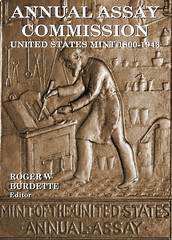 No, I haven't READ all of the great information on this four DVD set, but that's a tall order. Roger has assembled on these discs all known records and proceedings of the United States Mint Assay Commission from 1800 through its final year of 1980. Over 2,000 pages of archival records are included in convenient .pdf form.
No, I haven't READ all of the great information on this four DVD set, but that's a tall order. Roger has assembled on these discs all known records and proceedings of the United States Mint Assay Commission from 1800 through its final year of 1980. Over 2,000 pages of archival records are included in convenient .pdf form.
What a treasure trove for U.S. numismatic researchers! We are all in Roger's debt for making this information so readily available. Few of us, even the most dedicated numismatic researchers have the time, access and patience to locate and utilize these key primary records at the National Archives.
In his Introduction, Roger provides these notes on the sources:
Assay Commission records exist in multiple versions of each years’ meeting. The first official assay of gold and silver coins apparently took place in 1797, and annually thereafter. For commission meetings between 1840 and 1873 there are original meeting notes, a set of official minutes and usually a printed version of the minutes. Printed versions were intended for Congressional and administration officials, but were often limited to one hundred copies before the 1870s.
From about 1840 to 1911, minutes of the meetings were recorded by clerks in large journals. These manuscript minutes were the source of printed editions of each year’s proceedings. The manuscripts are unique, and include material not in the printed editions. Printed copies were commonly limited to between three hundred and four hundred, and are difficult to locate.
Most were printed in 8vo editions of approximately 40 pages. Printed editions sufficed for the official transcript of each Assay Commission meeting. The Annual Report of the Director of the Mint also includes a summary of the complete minutes. Additionally, the Secretary of the Treasury’s Annual Report com-monly included a very brief version. For the researcher, these derivative versions offer little of value and occasionally lead to misunderstanding due to omitted material.
In preparing this edition, the author has used the version prepared closest to the actual event and which promises to have the greatest fidelity to participant’s comments.
Also included is an essay by Robert W. Julian on The United States Annual Assay Commission 1797 to 1817, which previously appeared in Coin World.
The quality of the .pdf files I sampled was excellent. For example, I was able to easily extract the following paragraphs from the beginning of the section of Roger's transcriptions of the Monday, April 27, 1801 meeting at the Philadelphia Mint:
At a meeting of the Commissioners appointed by an act of Congress of 3rd March, 1801, for the purpose of inspecting the coins of the United States at the Mint of the United States on Monday the 27th day of April, 1801:
Present [were] Richard Peters, Esq., Judge [District Court of the United States for Pennsylvania]; Jared Ingersoll, [District] Attorney of the United States [for the Eastern District of Pennsylvania]; Stephen Moylan, Commissioner of Laws (sic – Loans) for the District of Pennsylvania;1 also the Director, Treasurer, Chief Coiner, Assayer, and Melter and Refiner of the Mint.
The Commissioners proceeded to count and examine the reserves of silver coins found in the chest under two locks, the keys of which has been kept by the Assayer and Treasurer [of the Mint], and compared them with the book in which they had been entered, and on finding them agreeably (sic) thereto; it was ordered that the whole of the reserved pieces should be melted into one mass, and assayed in two separate parcels.
Most other .pdf files consist of images of the original documents. Here's just one item relating to the 1817 assay.
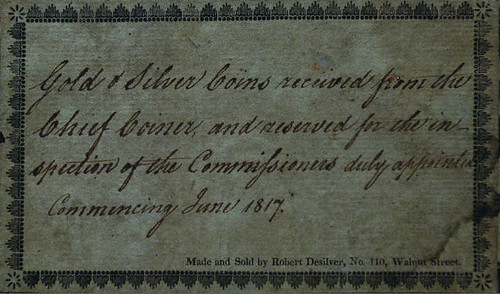
While the early records are handwritten, many later ones are typewritten. Even a short pass through the files on this collection leaves the reader in awe of the effort put into creating them and making the collection available in DVD format. Roger is a careful and meticulous researcher, and that clearly shows in the results of his compilation. In my opinion, the set is well worth a multiple of the list price and is an absolute bargain at the E-Sylum offer listed below.
The set of professionally packaged - the DVDs are housed in a nice protective case with catchy artwork and titles. My review copy was the library version, a larger plastic case preferred by librarians and well-suited for placement on a bookshelf. Inside, each of the four disks are professionally illustrated with different images and are clearly numbered for easy reference.
If you haven't already taken advantage of Roger's great offer for E-Sylum subscribers, time is running out. Annual Assay Commission – United States Mint 1800-1943 is available in a special first edition to readers of The E-Sylum for $25 postpaid until December 10, 2010. The regular retail price is $75. To order, send check or money order for $25 to: Seneca Mill Press LLC, PO Box 1423, Great Falls, VA 22066.
To read the earlier E-Sylum article, see: NEW BOOK: ANNUAL ASSAY COMMISSION – UNITED STATES MINT 1800-1943 (www.coinbooks.org/esylum_v13n45a03.html)
THE BOOK BAZARRE
JANUARY 8, 2011 NEW YORK AUCTION SALE HIGHLIGHTSClassic Works on Russian Coins and Medals From the
Library of Dr. Ira Rezak
Including: Frank Sternberg’s Exceptional Set of the French Edition of
G. Michailovich; Tolstoï on Fatherland War Medals, Great Novgorod and
Pskov; Chaudoir in Russian; Hutten-Czapski on Early Russian Coins;
Most of the Classic 20th Century Auction Sales; and Works by Demmeni,
Iversen, Oreshnikov, Prozorovskii, Sontsov, and Others
141 W JOHNSTOWN ROAD, GAHANNA OH 43230-2700
(614) 414-0855 • df@numislit.com • GFK@numislit.com
HARRY X BOOSEL'S 1873 COINAGE BOOK COVER PRINTING PLATE
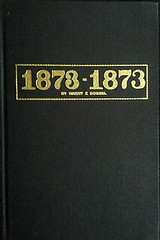 In other news, an interesting item popped up
at the Chicago Coin Club annual auction held on November
10th. The printing plate used to impress the
cover on Harry X Boosel’s book on 1873 coinage
fetched $80 in spirited bidding. Pictured here is the
printing plate itself and the book cover. As can be seen, the printing plate clearly illustrates the closed and open 3
types seen on 1873 coinage.
In other news, an interesting item popped up
at the Chicago Coin Club annual auction held on November
10th. The printing plate used to impress the
cover on Harry X Boosel’s book on 1873 coinage
fetched $80 in spirited bidding. Pictured here is the
printing plate itself and the book cover. As can be seen, the printing plate clearly illustrates the closed and open 3
types seen on 1873 coinage.
Relating the correct title of this book in print is something of an enigma. You can call it “1873-1873,” which seems to be the right name, but then you haven’t properly conveyed the idea of the closed and open 3s. Boosel would have loved our modern computers, which in theory should be able to implement a font that displays both the open and closed 3s correctly.
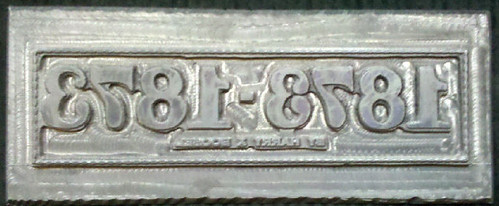
(Author’s note – we’ll leave this
as an exercise for the editor and see how he does! [Editor: I
tried all the fonts available on this Microsoft Publisher program
and here is the best I could do: ![]() . Can anyone do better?])
. Can anyone do better?])
Boosel’s other “nit” related to his middle name, which was a single letter X without a period. That one is a little bit easier to type correctly. Ye columnist was the successful bidder on this lot, and the underbidder related to me that he had other delectable Booseliana which I can not relate here, but trust me, it is neat stuff. We will have to get these pieces put back together at some point – it disturbs my sense of order to see this material broken up into multiple parts. Of course that is partly my fault for bidding too much!
For more information on the Liberty Seated Collectors Club, see: www.lsccweb.org
FEDERAL RESERVE TO OPEN DENVER MONEY MUSEUM

The Federal Reserve Bank of Kansas City says it will open a "Money Museum" and conference center at its Denver Branch next month.
The new features are part of extensive renovation to the first floor of the Denver Branch, at 1020 16th St. in downtown Denver.
The 7,000-square-foot Money Museum "will offer visitors a unique look at the nation’s central bank in action," the Fed said in a statement. "Visitors can learn more about the Federal Reserve through interactive exhibits that explore an efficient payment system, a safe and sound banking system, and how monetary policy provides for a stable economy."
The museum will offer samples of historical currency, an exhibit on detecting counterfeit notes, and "seeing $30 million dollars up close."
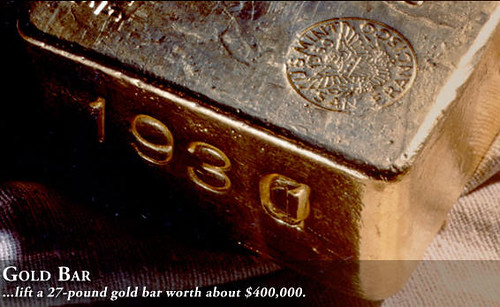
The museum is slated to open in January and will operate 8:30 a.m.-4:30 p.m. weekdays except bank holidays. When the museum opens, a website (www.kansascityfed.org/moneymuseum) will offer more information.
"The Denver Branch’s location in the heart of downtown, right on the 16th Street pedestrian mall, makes this a perfect spot to have a Money Museum and conference center," Mark Horan, the Fed's vice president of district facilities functions, said in the statement. "Plus with the U.S. Mint only a few blocks away, we anticipate a high volume of visitors."
The Denver Branch's public entrance is on Curtis Street. Photo IDs will be required for visitors 18 or older.
Civic, social and educational groups can make advance reservations and request guided tours and presentations via the website once it is active.
Kansas City is headquarters of the Fed's 10th District, which includes Colorado. The Denver Branch is one of the district's regional branches.
To read the complete article, see:
Fed's Denver Branch to open Money Museum
(www.bizjournals.com/denver/news/2010/12/02/
feds-denver-branch-to-open-money-museum.html)
"This will be something to complement what the Mint has," said Stacee Montague, spokeswoman for the Federal Reserve. "It will bring a little bit of excitement to the 16th Street Mall."
No firm plans are in place for how the grassy area surrounding the building will be made more enticing to pedestrians, but ideas being considered are displaying the large casks in which money is delivered to the bank or the old safe that has been with the Fed since it came to Denver in 1918.
Among displays being built for the museum is a case — about 6 feet tall and 8 feet wide — that will be stacked to the top with $30 million in $100 bills.
"You will be able to walk up to the case and say, 'So close, yet so far away,' " Montague said.
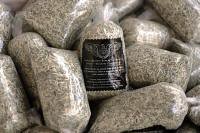 Visitors to the museum leave with a souvenir of $165 in money that has been shredded because it has become unfit for circulation.
Visitors to the museum leave with a souvenir of $165 in money that has been shredded because it has become unfit for circulation.
"We shred a lot of money a day," Montague said. "We either give it away or turn it into compost."
The museum won't be the first to be housed in a Federal Reserve bank. Kansas City, Cleveland and San Francisco are among the branches that have money museums.
To read the complete article, see: Money Museum should be worth a look (www.denverpost.com/business/ci_16773860)
The Harry S. Truman Library of Independence, Mo., has generously loaned a large number of coins from its 463-piece coin collection for display in the Federal Reserve Bank of Kansas City's Money Museum. The Truman Library collection of American coinage consists of examples of coins produced by the U.S. Mint during every presidential administration.
The Truman Coin Collection was created through a nationwide campaign to replace a similar collection belonging to Secretary of the Treasury John Snyder that was stolen in 1962. Joseph Stack, a New York coin dealer, took the lead by volunteering to catalog and arrange the coins that were donated to the Coin Restoration Program. Coins were received from 167 individual donors and coin clubs located across the country. On May 6, 1964, John Snyder and Joseph Stack presented the restored collection to the Truman Library.
To visit the money museum web site, see: www.kansascityfed.org/moneymuseum
THE STORY OF THE TRUMAN LIBRARY COLLECTION
In the late 1940's Joseph B. Stack, my uncle, became friends with John W. Snyder, Truman's Secretary of the Treasury. John W. Snyder was a coin collector and we at Stack's assisted him in forming a collection, different than others we had help develop.
The collection was in honor of all the Presidents' and featured one coin of each denomination that might have been issued during his Presidency. For example, for George Washington, you would need a Half Cent, large Cent , Half Dime, Dime, Quarter , Half Dollar, Silver Dollar, a Quarter Eagle, Half Eagle and Eagle. As long as each denomination was issued within the dates of the Presidency. You only need ONE. For Franklin D. Roosevelt you needed a Cent,5 Cent, Dime, Quarter and Half Dollar, one of each design of Commemorative Half Dollar issued during Roosevelt Presidency.
Each and every President was represented in similar manner,( If more than one design was issued during a Presidency, than an example of each design was part of the collection. In other words each President was repre- sented by a denomination, issued during his term of office, or you might consider this A PRESIDENTIAL TYPE SET. !
Each Presidential set was housed in large, white plastic holders,which I seem to remember measured 10 x 18 inches, a portrait of each president was an engraving obtained from the Bureau of Engraving mounted on the top of each holder, and gold stamped with the name of Each President, his years in office, and the denomination of each coin on display. It was surely an unusual idea and was great to work on. The quality ranged from lightly circulated to Mint State.
Before the collection was completed, John W. Snyder brought Harry S Truman into the Stack's Showroom on 46th Street, in order that the President could meet each of the Stack Family who were working on his collection.At that time, Morton, Joseph B., Harvey G, Benjamin and Norman were all present and we met Harry S. Truman in person. He stayed with us about an hour and questioned us about the collection, (There exists somewhere, maybe at Coin World or in one of our old files, the picture of Harry S. Truman being shown part of the developing collection by my uncle, Joseph B. Stack.
After the Truman Library was completed, John W. Snyder presented this Presidential Coin Collection to the Library.
The fact that each display board was somewhat different, it attracted loads of attention by the many thousands who visited the library.
It was so popular, that thieves broke into the Library and stole it. !
All were heartbroken, but there was at the time no funds available through the Parks Department (who were in charge of the Library) to replace it.
We at Stack's felt that the exposure of such a collection, and its educational value was so important, that the Stack Family, made a public appeal to collectors about the country to contribute a coin or two from their collection in order to rebuild the collection. The Stack Family made a substantial contribution itself.
The story made headlines in papers such as Coin World, Numismatic News and of course The Numismatist.
Contributions were sent to our offices, and the earliest to arrive that was needed, was set aside for rebuilding the collection. We bought ads in the trade publications, and Margo Russell, the early editor of Coin World, contacted us and said she would see that the story and progress of the restoration of the original collection, would be followed several time a month, as a news story, a progress report and not as an advertisement. That offer was a great contribution for getting contributions.
Many coins were sent in, duplicates were returned to the donor, who were asked, using a Want List, to contribute a different coin. Some wanted to contribute cash, but we didn't want to make this a commercial enterprise. So we asked those to purchase a missing coin from any dealer they wished, and send the coin to Stack's for inclusion in the collection. The appeal ran for about 2 years and the collection was completed (as it once existed !)
Each donor received a pro-forma receipt from Stack's, with the authority of the Park Department to issue same, and each donor received later an official receipt from the government.
The collection, in its new form, was returned to the Library, and was acknowledged as a Public and Stack Family Contribution.
It was a chore to do, and the Stack Family was proud to be part of it.
(I might add, that during the time the Stack Family was active in numismatics, we contributed coins, time and devotion to the collections at the Smithsonian, American Numismatic Society, American Numismatic Association, and numerous museums and library nationwide. We always felt that the more displayed, the more the public would appreciate the hobby, with the hope that coin collecting would grow in importance.)
"One of the most valuable and complete collections of U.S. coins in existence was stolen from the Truman Library in Independence, Mo., where it was being exhibited by its owner, H.S.T.'s onetime Secretary of the Treasury, John W. Snyder. Flying home from Manhattan to preside over the investigation, Truman had his own theory about who stole the $50,000 collection. "Professional thieves have been hired by some coin collector to come and get this collection," he fumed."
Source: Time Magazine, Friday, Nov 23, 1962
November 12, 1962 John W SYNDER's (1895-1985) coin collection was stolen from the Harry S Truman library. My 1906 Barber dime (minted at Denver) was among 167 donations accepted to help replace this collection. Under letter dated October 28, 1963, SYNDER sent me an autographed, series 1935 D, Silver certificate dollar bill. Rose CONWAY, President TRUMAN's (1884-1972) secretary and friend of my father, had Harry sign it for me April 1970 then I contacted Georgia Neese (Clark) GRAY (1900-1995) at her Topeka bank, whose signature appeared on some $30 billion dollars, she very graciously agreed to sign mine which occurred June 23, 1970. Mine may very well be the only (or among very few) such dollar bills with all three signatures, ---- our President, his Secretary of Treasury and Treasurer of the United States.
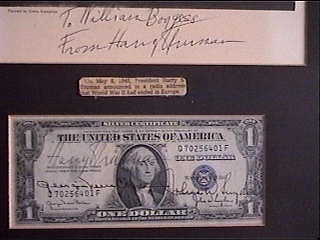
To read Bill Boggess's memoir, see: community-1.webtv.net/billboggess/WILLIAMSAMUELBOGGESS/
THE BOOK BAZARRE
QUERY: ENCASED COIN INFORMATION SOUGHT
NBS webmaster Bruce Perdue writes:
I have gotten into encased coins in a big way and have not found very much information on them anywhere. I am a member of ECI but wanted more so I bought the domain name encasedcoins.info and have put up a basic site with some pictures of encased coins. I am working on additional pages with more information and more images. I am looking for more information on encased coins. I have Bryan Ryker's book on Earl Fankhauser, but I am wondering if there is more out there on encased coins?
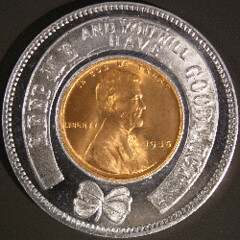
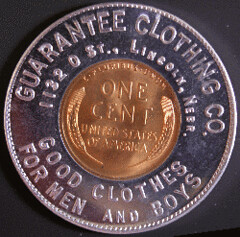
To visit Bruce's Encased Coins web site, see: www.encasedcoins.info
QUERY: GDC CASINO TOKEN MINT MARK
Ron Greene writes:
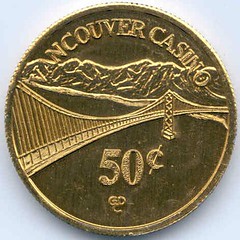 We have three British Columbia casino pieces, made of anodized aluminum, good for 50 cents or $1 which bear a mint mark GDC, the meaning of which has eluded me. The earliest is early 1990’s – I obtained one in 1994. I have been unsuccessful in finding out what company might have made them. I have attached a scan of one piece showing the mint mark. Perhaps an E-Sylum reader can help.
We have three British Columbia casino pieces, made of anodized aluminum, good for 50 cents or $1 which bear a mint mark GDC, the meaning of which has eluded me. The earliest is early 1990’s – I obtained one in 1994. I have been unsuccessful in finding out what company might have made them. I have attached a scan of one piece showing the mint mark. Perhaps an E-Sylum reader can help.
 The answer that came to my mind is Green Duck Corporation. A web search turned up a page with an image of the mint mark and this information: "Green Duck Corporation is a private U.S. mint. They changed their name into GDC Casino Tokens and in June 1999 the mint was closed."
-Editor
The answer that came to my mind is Green Duck Corporation. A web search turned up a page with an image of the mint mark and this information: "Green Duck Corporation is a private U.S. mint. They changed their name into GDC Casino Tokens and in June 1999 the mint was closed."
-Editor
To read the complete web page, see: Green Duck Corporation (www.jezuss.nl/gdc.htm)
THE ANA SCHOOL OF NUMISMATICS
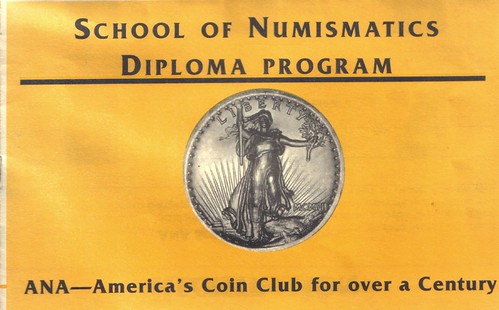
Ken Berger writes:
I found another brochure. It is an early 8-page brochure from the American Numismatic Association's School of Numismatics, Diploma Program. It discusses both the Diplomate of Numismatics, or Level I Program, and the Master of Numismatics, or Level II Program.
The inside has two pages of pictures of the twenty-two Charter Graduates. Some of the individuals pictured are: Q. David Bowers, Kenneth Bressett, John Davenport, Richard Doty, Chester Krause, Eric Newman, John Jay Pittman, Ed Rochette, Margo Russell, Harvey Stack, etc. Another page has pictures of the twelve Mentors; there is some overlap between the Mentors & Charter Graduates.

To view the complete brochure on Flickr, see: www.flickr.com/photos/coinbooks/sets/72157625496995866/show/
CARNEGIE HERO FUND MEDALS
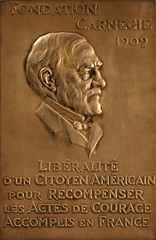
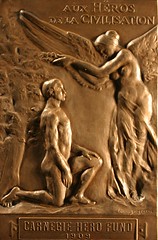
FRENCH MEDAL RE-ISSUED
The Hero Fund was pleased to play a role in securing a replacement medal for an American citizen from its sister hero fund in France, the Fondation Carnegie. Allan Thaler, 77, of West Haven, Conn., made the request for a replacement in February 2009, noting that his original medal had been lost over the years.
Thaler was cited by the French fund for rescuing a man from drowning in the Seine River in Paris in 1962, when he was visiting as a tourist. The Fondation agreed to the replacement, but the transaction was delayed by circumstances pertaining to its demise: After a century of activity, the foundation, which was established by Andrew Carnegie in 1909, ceased operations, and remaining funds were transferred to the Franco-American Commission for Educational Exchange, Paris.
The request for Thaler’s duplicate medal was not lost in the process, however, and the medal was sent by the Franco-American Commission to the Hero Fund in Pittsburgh in late October. Thaler, unfortunately, will not see the replacement, as he died two months after making his request. The medal was forwarded to his widow. Fondation Carnegie was one of 10 hero funds established in Western Europe after the initial success of the Pittsburgh-based Commission. Those remaining active are in the United Kingdom, Sweden, Switzerland, Italy, Denmark, Norway, Belgium, and the Netherlands.
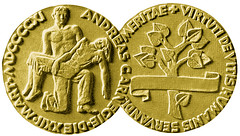 SWISS MEDAL REDESIGNED
SWISS MEDAL REDESIGNED
A new look for its medal has been given by the Carnegie Rescuers Foundation of Switzerland. The fund’s executive director, Hans-Ruedi Hübscher, said the medal was redesigned to give it a contemporary appearance. The engraving is in Latin and on the front gives founder Andrew Carnegie’s name with the date of foundation’s inception, March 22, 1911.
"We live in a heroic age,“ Carnegie wrote in establishing the foundation with a grant of $130,000. “Industrialization molds the heroes of peacetime. Hardly a day passes that a courageous deed is not communicated to one or another existing Hero Trust Funds."
The foundation recognizes those, who, on Swiss territory, risk their lives in peaceful endeavors to save the lives of their fellows. Awardees receive a certificate, and engraved bronze, silver, and gold medals are also awarded, as are wristwatches and monetary grants. Young heroes receive a voucher for a hot-air balloon ride or a helicopter flight.
Since the establishment of the foundation, more than 8,300 people have been recognized, and more than three million Swiss francs in subsidies have been paid to rescuers and their families. The awards are announced annually
GRANDPA CHENEY’S ‘CARNEGIE MEDAL’
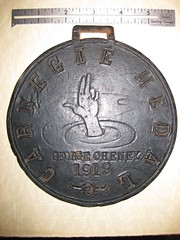 To date, there have been 9,391 awardees of the Carnegie Medal. The late George M. Cheney is not one of them, although someone somewhere along the line apparently thought that he deserved the honor and fashioned something of a knockoff. The “faux medal,” pictured here, was called to the attention of the Hero Fund earlier this year by Cheney’s grandson, Michael Long of Mission Viejo, Calif.
To date, there have been 9,391 awardees of the Carnegie Medal. The late George M. Cheney is not one of them, although someone somewhere along the line apparently thought that he deserved the honor and fashioned something of a knockoff. The “faux medal,” pictured here, was called to the attention of the Hero Fund earlier this year by Cheney’s grandson, Michael Long of Mission Viejo, Calif.
Long, a firefighter and paramedic with the Orange County, Calif., Fire Department, provided details of his grandfather’s short, albeit colorful, life, but the family knows nothing about the circumstances for which the medal given. Cheney was born in North Adams, Mass., in 1887, and after graduating from Williams College and then the Colorado School of Mines in 1917, he set off for a career in mining in Mexico, Ecuador, Peru, and Chile. He met his wife, a U.S. embassy worker, in Peru, and the couple were married in 1924. In 1932, Cheney, who was a general foreman, and five other workers were killed in a mining blast in Chile. His widow and two daughters, including Elena, Long’s mother, relocated to the U.S.
Long says the medal has been in his family for years, but “we’ve never understood if it had any significance.” The Hero Fund could only confirm that the medal was an imitation of the original, which Long says is “the best expression of humanity I have ever come across.”
To learn more about the Carnegie Hero Fund Commission, see: www.carnegiehero.org
THE BOOK BAZARRE
“We All Have Our Hobbies!”MORE ON SABINE PASS MEDAL COPIES
Regarding what he believed to be a replica Davis Guards Sabine Pass medal, last week eBay seller Lloyd Wagner asked:
Is this in fact a copy? Any help or advice would certainly be appreciated!
I was in fact bidding on this item, as I knew exactly what it was, or what it seemed to be. I shared the same problem that Lloyd faces now: Is it real, or isn't it?
As the auction closed, I was about 98% sure this item was a replica. I found pictures online for three or four authentic specimens, and all of them markedly finer quality than the one listed on eBay. Still, I had some remaining doubt because while none of the authentic specimens matched the one on eBay, none of the authentic specimens matched each other, either. They were all hand-engraved, and all unique. In the end, I bid about 2% of the last sale price I could find for an authentic specimen. Even so, it was annoying to get outbid!
Several days later, the American Numismatic Society online collection database came back online. It turns out that the ANS has four Sabine Pass medals with excellent pictures, and unlike all of the other pictures I had found, one of the ANS specimens is a _very_ good stylistic match for the one on eBay.
As you can imagine, I was *very* annoyed at that point that I hadn't bid higher!
Fortunately, for me, that annoyance lasted only a minute or two, until I read the full ANS record. The last line of the record reads, "Fake Davis Guards Medal".
Phew!
The silly thing is, it might even be a good buy at $1,000 as a replica. I don't know. It's not a common replica, anyway. And the last couple of real ones sold for $30,000-$40,000...
So I wish I knew if it was a close call and I should be glad I got outbid, or close call and I should have bid higher!


Lloyd Wagner example
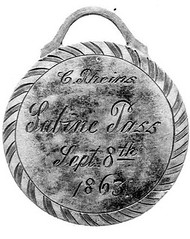
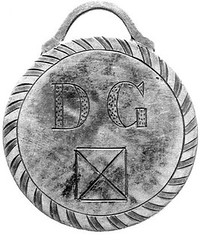
To view the ANS collection database entries, see:
numismatics.org/collection/1967.226.1053
numismatics.org/collection/1909.350.1
numismatics.org/collection/1974.64.1
numismatics.org/collection/1973.73.1
To read the earlier E-Sylum article, see: QUERY: SABINE PASS MEDAL COPIES (www.coinbooks.org/esylum_v13n48a20.html)
NOTES FROM E-SYLUM READERS: DECEMBER 5, 2010
Joe Boling writes:
On Whitman's "Vault" books, they also did World War II: Saving the Reality, A Collector's Vault. It has an egregious numismatic error on page 56, where it shows two 20-mark notes, one allegedly a British forgery of the German original - dated 1910. Those notes were wiped out by the 1923 hyperinflation, and would never have been a subject of British forgery in WWII (and as far as in know, were not such a subject during WWI, either).
To read the earlier E-Sylum article, see: MORE ON THE WHITMAN 'VAULT' BOOKS (www.coinbooks.org/esylum_v13n48a11.html)
On another topic Joe adds:
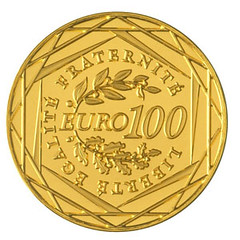 The data list on that circulating gold 100 euro piece from France gives weights in grams and ounces - the latter being avoirdupois. The troy weight is 0.0997oz. With gold around $1380 and the euro at $1.32 tonight, the face value is under bullion value. They should be selling out. They are certainly not going to circulate.
The data list on that circulating gold 100 euro piece from France gives weights in grams and ounces - the latter being avoirdupois. The troy weight is 0.0997oz. With gold around $1380 and the euro at $1.32 tonight, the face value is under bullion value. They should be selling out. They are certainly not going to circulate.
To read the earlier E-Sylum article, see: NEW COINS FROM LATVIA AND FRANCE (www.coinbooks.org/esylum_v13n48a22.html)
Regarding Dave Bowers' query,
I don't have the equipment that does this but years ago used LP2CD.com to transfer music from older LP records to audio CDs. They apparently can do transfers from all types of media, including wire recordings. If this is the same technology the transfers are a little pricey, but might be a possibility.
To visit the LP2CD wire recordings page, see: www.lp2cd.com/wire_recordings.htm
To read the earlier E-Sylum article, see: QUERY: TRANSFERRING AUDIO FROM MAGNETOPHONE RECORDINGS (www.coinbooks.org/esylum_v13n48a19.html)
ON SWITCHING FROM AOL
Tom Mulvaney writes:
Thanks for changing my email address for E-Sylum delivery. It came through just fine on the "new" address I gave you. On AOL, it was still "unavailable". I sure don't know what AOL has done to me as I have used that address for many, many years with few, if any, problems until a month ago.
Warner Talso writes:
I note the discussion of AOL that included this phrase (and others like it): "Their system is set up to discourage anyone from talking to them on the issue. I fought AOL for over five years and finally gave up. "
The truth is that the AOL business model is moving away from individual customers. They would just as soon you go to a different provider. When I contacted them about a problem, the advice was to "switch to another provider". Simple and straight-forward. I was told they really didn't want people like me as customers.
I will be switching as soon as I get my act together. That means finding a way to transfer my email addresses, favorite places, and other history files to the new provider. I would be interested in hearing of the experience of anyone who has swapped and the details of how they did it.
To read the earlier E-Sylum article, see: AOL: ABANDON HOPE ALL YE WHO SUBSCRIBE HERE (www.coinbooks.org/esylum_v13n48a03.html)
THE BOOK BAZARRE
OBAMA PARDONS MAN CONVICTED OF COIN MUTILATION
Rick Bottles writes:
Do you have any further information on the Pennsylvania Man that Obama just pardoned for mutilating coins back in the 60's?
President Barack Obama has granted the first pardons of his presidency, to nine people convicted of crimes including possessing drugs, counterfeiting and even mutilating coins.
No one well-known was on the list, and some of the crimes dated back decades or had drawn little more than a slap on the wrist in the first place — such as the Pennsylvania man sentenced in 1963 to probation and a $20 fine for mutilating coins. The White House didn't explain the charge, but tampering with federal currency is a crime.
The White House declined to give details on the cases or comment on why these particular people were selected by a president who previously had only pardoned Thanksgiving turkeys.
To read the complete article, see: Obama pardons 9 convicted of drug, other offenses (news.yahoo.com/s/ap/20101203/ap_on_go_pr_wh/us_obama_pardons)
Dick Johnson writes:
There is hope for every coin dealer or collector who has mutilated a coin. You can eventually receive a presidential pardon even if you are caught, arrested and convicted. It happed this week to a 66-year old man who "sweated" cents to make them fit in dime vending machines in military barracks laundry, cigarette and soda machines 47 years ago.
In one of the most bizarre news items this week, President Barack Obama granted nine pardons, one of which was to Ronald Lee Foster of Beaver Falls, PA. As a U.S. Marine in 1963 he was fined $20 for reducing the size of cents -- the correct term is "sweating" -- to the size of dimes which he fed into nearby vending machine in the barracks where he was living. "Well, we were only making only $82 a month," said Foster in a recent interview. "We were using them in the washing machines, the dryers, the cigarette machines and the pop machines on the base in our barracks."
Foster, now 66, said he wasn't aware that he even had a felony conviction on his record until he applied for a gun permit in Pennsylvania five years ago and was denied. After getting out of the Marines in 1966, Foster returned to Pennsylvania and spent 27 years as a supervisor at a ceiling plant and also served on the local zoning board. He also spent 35 years as a volunteer firefighter.
His attorney had applied for the presidential pardon without his knowledge. Surprise! In a week where turkeys were pardoned at the White House, he also received the presidential reprieve.
To read the complete article, see:
Obama pardons 9 people
(www.google.com/hostednews/ap/article/
ALeqM5juCUJ6mPbj8_p9jKSGetnpNYH8dA?docId=2ee4f5ad11da4081ba817db297e38887)
ANCIENT COINS STOLEN FROM GERMANY'S FROM FROM SCHLOß HOHENTÜBINGEN

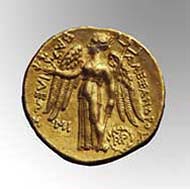
At the Museum Schloss Hohentübingen, Tübingen (Germany, Baden-Württemberg), 44 antique coins were stolen from a showcase in the public exhibition room. The theft was reported to the local criminal investigation department on Wednesday November 24. The delinquent(s) are still unknown.
The stolen pieces include Hellenistic and Roman imperial coins. Obviously, the thieves were especially interested in gold coins, for they took 37 staters, aurei and solidi, furthermore 5 coins of silver and 2 of bronze. Among the stolen pieces there are some exemplars of excellent quality, which are, inter alia, of great importance for research on the iconography of Roman imperial portraiture.
If you see the stolen coins or if they are offered to you, please inform Dr Thomas Schäfer, University of Tübingen, Tel.: +49 / 71 / 29 72 378. For sending an email click here.
For a list of the stolen coins plus pictures, click here.
Pass it on! The more dealers and collectors keep their eyes open, the greater the chance to regain the stolen coins! Please forward the link to this information to all of your collector friends. Maybe one of them will discover these coins in one of the innumerable web auctions!
To read the complete article, see: Theft of precious ancient coins from Schloß Hohentübingen / Germany (www.coinsweekly.com/en/page/4?&id=348)
FEATURED WEB PAGE: ARTISTS ON BANKNOTES
This week's Featured Web Page is the Artists page from Akhtar Ahmed Rasha's Paper Exhibition web site.
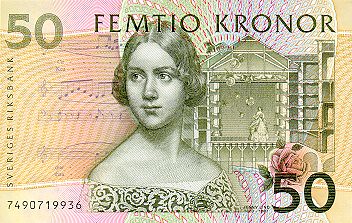
www.paperexhibition.com/paper-money/artists
